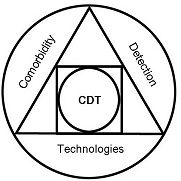 CD Technologies – Comorbidity Detection Technologies (CDT) – is a dynamic multidisciplinary company dedicated to mathematical diagnostic modeling of aging and aging-related diseases, for the purposes of their early preventative and personalized therapy.
CD Technologies – Comorbidity Detection Technologies (CDT) – is a dynamic multidisciplinary company dedicated to mathematical diagnostic modeling of aging and aging-related diseases, for the purposes of their early preventative and personalized therapy.
CDT develops the practically applicable and at the same time sophisticated expert software system for indication of physiological age, for early diagnosis of aging-related ill health and personalization of aging-related and healthspan extending treatments – “The Quantified Longevity Guide – QLG”. The system will facilitate early detection and corresponding preventive early treatment of major aging-related diseases (such as cancer, Alzheimer’s disease, heart disease and diabetes), based on the assessment of physiological age.
The main advantage of the proposed system is in terms of methodology: Providing an integrated approach that will take into consideration the non-linear interrelation of a multitude of parameters – biomarkers and intervention factors, using information theoretical measures, such as entropy and mutual information, rather than linear statistical measures.
The proposed Expert Software System will use the methodology of information theory that will uniquely allow the selection of the most beneficial and economical individual factors and factors’ combinations for combating chronic age-related diseases and increasing the health span, indicating physiological age as a cost-effective method of preclinical diagnosis for a variety of chronic age-related diseases, while enabling long-term evaluation and prediction of effectiveness of individual and combined therapies.
Endpoint product capabilities: Basic computational software technologies, algorithms, diagnostic models, tools and platforms will be developed that will serve physicians, biomedical researchers and general health-conscious consumers.
In addition to diagnostic modeling, CDT team of experts in bioinformatics, biology, social and research aspects of aging and aging-related diseases performs consultancy, analysis and education services for the public and the professional community on aging and longevity research, facilitates the communications between the public and researchers on the one hand, and between the researchers and potential sponsors and decision makers on the other.
CDT is a partner of the Israeli Longevity Alliance (ISRLA)
More information at: http://www.qlongevityguide.com/
Team
As this is primarily a health data analysis project, the initial team comprises experts in the relevant fields:
Dr. David Blokh, Chief Technology Officer. Algorithm developer.
He obtained his Ph.D. degree from the Ben-Gurion University of the Negev, Israel. His research interests include combinatorial optimization, information-theory analysis and pattern recognition, applying advanced data mining techniques in biomedicine. His papers have appeared in Progress in Neurobiology, Discrete Applied Mathematics, Methods of Information in Medicine, Computer Methods and Programs in Biomedicine, Cancer Detection and Prevention, Aging and Disease, and other journals. He holds a patent and patent application. david_blokh@012.net.il
Dr. Ilia Stambler. Chief Executive Officer. Analyst.
He obtained his Ph.D. degree from Bar Ilan University, Israel. His research focuses on the historical and social implications of biomedical research of aging and life extension. He is also involved in research for modeling aging and life-extending processes and aging-related diseases. He has been involved in education and advocacy for biomedical aging research. He is the author of A History of Life-extensionism in the Twentieth Century. His papers have appeared in Progress in Neurobiology, Aging and Disease, Cancer Detection and Prevention, Rejuvenation Research, Current Aging Science, Global Aging, Frontiers in Genetics, and other journals. ilia.stambler@gmail.com
Mr. Ilia Kreiman, Software Engineer
He holds B.Th. degree from Negev Academic College of Engineering, Israel. He has many years of experience in signal data processing, analysis and development of algorithms, software development and programming of enterprise-wide medical information system solutions. He holds 4 patents. ilia.kreiman@gmail.com
Note: In time, the team can be expanded, especially with the addition of physicians, biologists and data technicians. New collaborations can be formed with relevant organizations, particularly those involved in biomedical data mining, diagnostic research and health information distribution. Due to the open and cumulative nature of this project, it can be scaled up to almost any dimension, depending on the funding, number of people involved and accessibility of data.
Please address project-related correspondence to Ilia Stambler ilia.stambler@gmail.com
Selected Publications
Blokh D and Stambler I., 2014. Estimation of Heterogeneity in Diagnostic Parameters of Age-related Diseases. Aging and Disease, 5, 218-225. http://www.aginganddisease.org/EN/10.14336/AD.2014.0500218
Blokh D and Stambler I., 2015. Information theoretical analysis of aging as a risk factor for heart disease. Aging and Disease, 6, 196-207.http://www.aginganddisease.org/EN/10.14336/AD.2014.0623
Blokh D and Stambler I, 2015. Applying information theory analysis for the solution of biomedical data processing problems. American Journal of Bioinformatics, 3 (1), 17-29.http://thescipub.com/abstract/10.3844/ajbsp.2014.17.29
Blokh D and Stambler I, 2016. The application of information theory for the research of aging and aging-related diseases. Progress in Neurobiology, doi:10.1016/j.pneurobio.2016.03.005,http://www.sciencedirect.com/science/article/pii/S0301008215300599
Blokh D, Afrimzon E, Stambler I, Korech E, Shafran Y, Zurgil N, Deutsch M, 2006. Breast cancer detection by Michaelis-Menten constants via linear programming. Computer Methods and Programs in Biomedicine, 85, 210-213.http://www.ncbi.nlm.nih.gov/pubmed/17188399
Blokh D, Stambler I, Afrimzon E, Shafran Y, Korech E, Sandbank J, Orda R, Zurgil N, Deutsch M., 2007. The information-theory analysis of Michaelis–Menten constants for detection of breast cancer. Cancer Detection and Prevention, 31, 489-498.http://www.ncbi.nlm.nih.gov/pubmed/18061365
Blokh D, Zurgil N, Stambler I, Afrimzon E, Shafran Y, Korech E, Sandbank J, Deutsch M., 2008. An information-theoretical model for breast cancer detection. Methods of Information in Medicine, 47, 322-327. http://www.ncbi.nlm.nih.gov/pubmed/18690365
Blokh D, Stambler I, Afrimzon E, Platkov M, Shafran Y, Korech E, Sandbank J, Zurgil N, Deutsch M., 2009. Comparative analysis of cell parameter groups for breast cancer detection. Computer Methods and Programs in Biomedicine, 94, 239-249.http://www.ncbi.nlm.nih.gov/pubmed/19231022
Blokh D, 2013. Information-Theory Analysis of Cell Characteristics in Breast Cancer Patients. International Journal on Bioinformatics & Biosciences (IJBB), 3 (1).http://wireilla.com/papers/ijbb/V3N1/3113ijbb01.pdf
Stambler I, 2015. Stop Aging Disease! ICAD 2014. Aging and Disease, 6 (2), 76-94http://www.aginganddisease.org/EN/10.14336/AD.2015.0115
Jin K, Simpkins JW, Ji X, Leis M and Stambler I. 2015. The Critical Need to Promote Research of Aging and Aging-related Diseases to Improve Health and Longevity of the Elderly Population. Aging and Disease, 6(1), 1-5http://www.aginganddisease.org/EN/10.14336/AD.2014.1210

